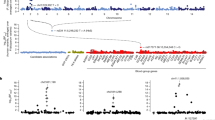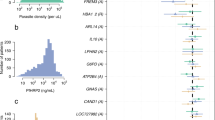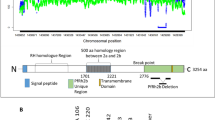Abstract
Complement receptor 1 (CR1) expression level on erythrocytes is genetically determined, and in Caucasian populations is linked to high (H) and low (L) expression alleles identified by a HindIII restriction fragment length polymorphism (RFLP). Erythrocyte CR1 may be an important factor in determining malaria susceptibility, as low expression of CR1 reduces the rosetting of uninfected erythrocytes with Plasmodium falciparum-infected cells, a process that contributes to malaria pathogenesis. Prior to studying CR1 expression and malaria susceptibility, we have investigated whether the quantity of erythrocyte CR1 correlates with the H and L alleles in an African population. Mean erythrocyte CR1 in 149 Malian adults was 415 molecules per cell, which is comparable to Caucasian populations; however, there was no relationship between erythrocyte CR1 level and genotype for the HindIII RFLP (mean CR1 per erythrocyte HH=414, HL=419 and LL=403, P>0.1, Student's t-test). The conclusions of a previous study of erythrocyte CR1 expression level and malaria susceptibility in West Africa that was based on HindIII RFLP genotyping may therefore need to be re-evaluated.
This is a preview of subscription content, access via your institution
Access options
Subscribe to this journal
Receive 6 digital issues and online access to articles
$119.00 per year
only $19.83 per issue
Buy this article
- Purchase on Springer Link
- Instant access to full article PDF
Prices may be subject to local taxes which are calculated during checkout



Similar content being viewed by others
References
Birmingham DJ, Hebert LA . CR1 and CR1-like: the primate immune adherence receptors Immunol Rev 2001 180: 100–111
Rowe JA, Moulds JM, Newbold CI, Miller LH . P. falciparum rosetting mediated by a parasite-variant erythrocyte membrane protein and complement-receptor 1 Nature 1997 388: 292–295
Carlson J, Helmby H, Hill AV, Brewster D, Greenwood BM, Wahlgren M . Human cerebral malaria: association with erythrocyte rosetting and lack of anti-rosetting antibodies Lancet 1990 336: 1457–1460
Rowe A, Obeiro J, Newbold CI, Marsh K . Plasmodium falciparum rosetting is associated with malaria severity in Kenya Infect Immun 1995 63: 2323–2326
Kaul DK, Roth EFJ, Nagel RL, Howard RJ, Handunnetti SM . Rosetting of Plasmodium falciparum-infected red blood cells with uninfected red blood cells enhances micro-vascular obstruction under flow conditions Blood 1991 78: 812–819
Rowe JA, Obiero J, Marsh K, Raza A . Positive correlation between rosetting and parasitemia in Plasmodium falciparum clinical isolates Am J Trop Med Hyg 2002 66: 458–460
Moulds JM, Moulds JJ, Brown M, Atkinson JP . Antiglobulin testing for CR1-related (Knops/McCoy/Swain-Langley/York) blood group antigens: negative and weak reactions are caused by variable expression of CR1 Vox Sang 1992 62: 230–235
Wilson JG, Murphy EE, Wong WW, Klickstein LB, Weis JH, Fearon DT . Identification of a restriction fragment length polymorphism by a CR1 cDNA that correlates with the number of CR1 on erythrocytes J Exp Med 1986 164: 50–59
Herrera AH, Xiang L, Martin SG, Lewis J, Wilson JG . Analysis of complement receptor type 1 (CR1) expression on erythrocytes and of CR1 allelic markers in Caucasian and African American populations Clin Immunol Immunopathol 1998 87: 176–183
Wong WW, Cahill JM, Rosen MD et al. Structure of the human CR1 gene. Molecular basis of the structural and quantitative polymorphisms and identification of a new CR1-like allele J Exp Med 1989 169: 847–863
Xiang L, Rundles JR, Hamilton DR, Wilson JG . Quantitative alleles of CR1: coding sequence analysis and comparison of haplotypes in two ethnic groups J Immunol 1999 163: 4939–4945
Kumar A, Malaviya AN, Sinha S, Khandekar PS, Banerjee K, Srivastava LM . C3b receptor (CR1) genomic polymorphism in rheumatoid arthritis Low receptor levels on erythrocytes are an acquired phenomenon Immunol Res 1994 13: 61–71
Chakraborty R, Kamboh MI, Nwankwo M, Ferrell RE . Caucasian genes in American blacks: new data Am J Hum Genet 1992 50: 145–155
Klickstein LB, Moulds JM . CR1 In: Morley BJ, Walport MJ (eds) The Complement Factsbook Academic Press: New York 2000 pp. 136–145
Waitumbi JN, Opollo MO, Muga RO, Misore AO, Stoute JA . Red cell surface changes and erythrophagocytosis in children with severe Plasmodium falciparum anemia Blood 2000 95: 1481–1486
Bellamy R, Kwiatkowski D, Hill AV . Absence of an association between intercellular adhesion molecule 1, complement receptor 1 and interleukin 1 receptor antagonist gene polymorphisms and severe malaria in a West African population Trans R Soc Trop Med Hyg 1998 92: 312–316
Acknowledgements
We are grateful to the volunteers in Houston and Mali who donated blood for this study. We also thank the physicians and staff of the Bandiagara Traditional Medicine Centre and Health Centre, the Bandiagara Traditional Healers Association, and the community of Bandiagara.
Author information
Authors and Affiliations
Corresponding author
Additional information
This work was funded by the Wellcome Trust (grant no 055167), the National Institutes of Health (grant no R01 AI42367, contract no N01-AI-85346 and grant no 5P50AI39469), the UNDP/World Bank/WHO TDR/Multilateral Initiative on Malaria (grant no 980152) and the International Atomic Energy Agency's Department of Technical Co-operation.
Rights and permissions
About this article
Cite this article
Rowe, J., Raza, A., Diallo, D. et al. Erythrocyte CR1 expression level does not correlate with a HindIII restriction fragment length polymorphism in Africans; implications for studies on malaria susceptibility. Genes Immun 3, 497–500 (2002). https://doi.org/10.1038/sj.gene.6363899
Received:
Accepted:
Published:
Issue Date:
DOI: https://doi.org/10.1038/sj.gene.6363899
Keywords
This article is cited by
-
Quantitative comparative analysis of human erythrocyte surface proteins between individuals from two genetically distinct populations
Communications Biology (2019)
-
Complement Receptor 1 availability on red blood cell surface modulates Plasmodium vivax invasion of human reticulocytes
Scientific Reports (2019)
-
No Evidence that Knops Blood Group Polymorphisms Affect Complement Receptor 1 Clustering on Erythrocytes
Scientific Reports (2017)
-
Red blood cell complement receptor one level varies with Knops blood group, α+thalassaemia and age among Kenyan children
Genes & Immunity (2016)
-
Human genetic polymorphisms in the Knops blood group are not associated with a protective advantage against Plasmodium falciparum malaria in Southern Ghana
Malaria Journal (2013)



